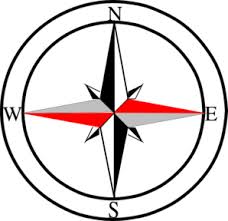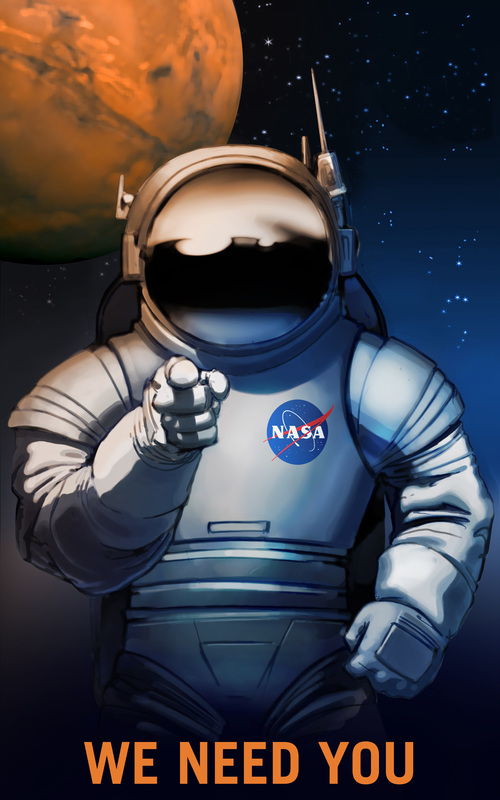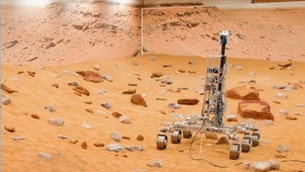|
Image: NASA/KSC
|
Mission Possible...
Mission 1: My Interests List
Using paper and pencil or a keyboard, list words that describe you.
For 3 minutes, you will write non-stop. Do not edit, just keep writing.
After the timer goes off, we will debrief.
You will have the opportunity to share, but you will not be required to share.
For 3 minutes, you will write non-stop. Do not edit, just keep writing.
After the timer goes off, we will debrief.
You will have the opportunity to share, but you will not be required to share.
Mission 2: Visual Thinking - Compass Points Routine

E = Excited
What excites you about the idea of going to Mars?
What is the upside? Why?
W = Worrisome
What do you find worrisome about the idea of going to Mars?
What is the downside?Why?
N = Need to Know
What else do you need to know about going to Mars?
What additional information would help you evaluate the prospect of going to Mars?
S = Stance
What is your current stance on the idea of going to Mars?
How might you move forward in your evaluation of the potential journey?
More Visible Thinking Routines by the Harvard Project Zero
What excites you about the idea of going to Mars?
What is the upside? Why?
W = Worrisome
What do you find worrisome about the idea of going to Mars?
What is the downside?Why?
N = Need to Know
What else do you need to know about going to Mars?
What additional information would help you evaluate the prospect of going to Mars?
S = Stance
What is your current stance on the idea of going to Mars?
How might you move forward in your evaluation of the potential journey?
More Visible Thinking Routines by the Harvard Project Zero
Resource: Augmented Reality
NASA's Spacecraft 3D is an augmented reality (AR) application. Explore a variety of spacecraft that orbit earth, are our eyes on Mars, and venture out beyond the habitable zone in our solar system.
Download NASA's Spacecraft 3D:
Download NASA's Spacecraft 3D:
Get your target so you can use NASA's Spacecraft 3D:
NASA's 3DV is an augmented reality (AR) application that gives you the ability to view three dimensional models of space vehicles and equipment, move and rotate vehicles and equipment, and totally immerse yourself in various NASA scenes. This is a MUST SEE application
Download NASA's 3DV Mobile App:
Get your targets so you can use NASA's 3DV. The Black and white target is for web based app and the color target is for the mobile app.
Don't forget Robonaut 2 (Yes, they call him "R2"):
Mission 3: Develop a Type I
You have had several Type I learning opportunities modeled for you and you have been introduced to several Mars related Type I starters. Now it is your turn to develop a Type I...
You have choices:
Remember, when developing a Type I it should either be a major event (e.g. Elon Musk comes to visit your school) or the activity needs to be dynamic and require the student to engage. To accomplish this require students to:
When you are done, share your Type I because...
"The more we share, the more we have." -Leonard Nimoy
You have choices:
- You can develop a Mars related Type I to stimulate new interests that might lead to more intensive follow-up.
- You can develop a Type I based on the documented interests of a current or past student.
- You can develop a Type I based on your interests to expand the scope of your students' experience.
Remember, when developing a Type I it should either be a major event (e.g. Elon Musk comes to visit your school) or the activity needs to be dynamic and require the student to engage. To accomplish this require students to:
- Heighten Anticipation
- Stimulate Interest
- Deepen Understanding and Connection
When you are done, share your Type I because...
"The more we share, the more we have." -Leonard Nimoy
Mission 4: Survival on Mars
Mission 5: Critique a Type II
| Type II |
With the release of the movie "The Martian" (Director, Ridley Scott), engaging students 13 and over becomes even easier! Check out this NASA piece that dissects the movie comparing technologies that Mark Watney (Matt Damon) uses and develops in the movie with real technologies that will be used on the planned mission to Mars.
Nine Real Technologies in 'The Martian'
Nine Real Technologies in 'The Martian'
Mission 6: Regolith Box
Mission 7: SWOT
| swot_analysis_handout.docx |
Mission 8: Design Printable Habitats
Designing habitats for Mars colonization is truly challenging. Considerations like available materials and energy sources have to be weighed against human needs like water, light, and protection from the hostile Mars terrain. It requires research, problem solving, creativity, design, and collaboration. Use these rules from NASA, AmericaMake, and Make for the project: 3D Printed Habitat Challenge
An aside for teachers: This is the kind of open ended probleming solving that Elon Musk championed recently (NOTE: HE IS NOT AN EDUCATOR NOR DOES HE HAVE ANY EXPERTISE IN EDUCATION. Yes, I just yelled...) and expert educators (e.g. Renzulli, Reis, VanTassel-Baska, Kaplan, Dewey) have been championing for a very long time. Dewey wrote his ideas almost 100 years ago!
I am providing a link to some examples of designs in the competition, but I caution: When you provide students with examples, they may work to the example rather developing truly innovative designs. Examples
An aside for teachers: This is the kind of open ended probleming solving that Elon Musk championed recently (NOTE: HE IS NOT AN EDUCATOR NOR DOES HE HAVE ANY EXPERTISE IN EDUCATION. Yes, I just yelled...) and expert educators (e.g. Renzulli, Reis, VanTassel-Baska, Kaplan, Dewey) have been championing for a very long time. Dewey wrote his ideas almost 100 years ago!
I am providing a link to some examples of designs in the competition, but I caution: When you provide students with examples, they may work to the example rather developing truly innovative designs. Examples
Before you go...
Please take a moment to provide feedback about your experience today.
Thank you in advance for your time!
Thank you in advance for your time!
Other Internet Resources
NASA for Educators
Desktop Model of NASA Spacecraft Orion
NASA Journey to Mars
Discovery Channel: Race to Mars - Part 1
Discovery Channel Race to Mars - Part 2
SCOOL: NASA Satellite Tracking
The Mars Society Curriculum Corner
NASA: Mars for Educators
Mars Explorers Wanted Posters
NASA Competitions for Students
NASA Opportunities for Students
A Year in Space - The Video
Careers at NASA
Documentary on Curiosity's Scientists / Engineers
Desktop Model of NASA Spacecraft Orion
NASA Journey to Mars
Discovery Channel: Race to Mars - Part 1
Discovery Channel Race to Mars - Part 2
SCOOL: NASA Satellite Tracking
The Mars Society Curriculum Corner
NASA: Mars for Educators
Mars Explorers Wanted Posters
NASA Competitions for Students
NASA Opportunities for Students
A Year in Space - The Video
Careers at NASA
Documentary on Curiosity's Scientists / Engineers


